|
HISTORY OF
DANCE
Modern
dancing is evolving in ways that academics could not possibly have
imagined, driven by street sounds that drive the body to express itself
in different ways: freestyle, and who hasn't felt the urge to break into
dance when a song with a great beat is playing. Even here conventions
have developed freestyle into a recognised art form. Talent shows are
doing much the same, driving stage performances to new heights of synchronization
and originality as you can see below - and the phenomenon is worldwide.
The essential element to all of this is music, which binds the dancer(s)
to a time signature or otherwise triggers parts of the performance.
Apart
from the need to be fit, a truly great dancers needs to have timing and rhythm.
One of the greatest dancers of all time was Fred Astaire, who clacked
his way expressively with his partner Ginger Rogers. He was the
original flexible man, with a timing perfection and stamina hard to
match percussively, that any drummer would be proud of.
Skating
on ice is equally demanding and a whole new set of skills that thrill
the audience, such as Torvill and Dean and their version of Ravel's
Bolero.
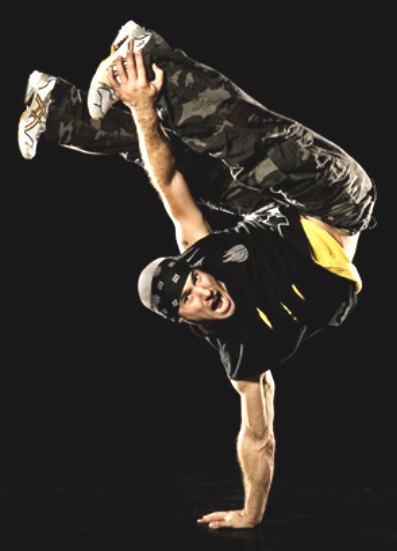
BREAK
DANCING
B-boying or breaking, often called "breakdancing", is a style of street dance that originated as a part of hip hop culture among African American and Latino youths in New York City during the early
1970s. Fast to gain popularity in the media, the dance style also gained popularity worldwide especially in South Korea, France, Russia, Japan, and Brazil. While extremely diverse in the amount of variation available in the dance, b-boying consists of four primary elements: toprock, downrock, power moves, and freezes. B-boying is typically danced to hip-hop and especially breakbeats, although modern trends allow for much wider varieties of music along certain ranges of tempo and beat patterns.
A practitioner of this dance is called a b-boy, b-girl, or breaker. Although the term "breakdance" is frequently used to refer to the dance, "b-boying" and "breaking" are the original terms. These terms are preferred by the majority of the art form’s pioneers and most notable practitioners.
TERMINOLOGY
The terminology used to refer to b-boying changed after promotion by the mainstream media. Although widespread, the term "break-dancing" is looked down upon by those immersed in hip-hop culture. Purists consider "breakdancing" an ignorant term invented by the
media:58 that connotes exploitation of the art:60 and is used to sensationalize breaking. The term "breakdancing" is also problematic because it has become a diluted umbrella term that incorrectly includes popping, locking, and electric
boogaloo, which are not styles of "breakdance", but are funk styles that were developed separately from breaking in
California. The dance itself is properly called "breaking" according to rappers such as KRS-One, Talib Kweli, Mos Def, and Darryl McDaniels of
Run-DMC.
The terms "b-boy" (break-boy), "b-girl" (break-girl), and "breaker" are the original terms used to describe the dancers. The original terms arose to describe the dancers who performed to DJ Kool Herc's breakbeats. DJ Kool Herc is a Jamaican-American DJ who is responsible for developing the foundational aspects of hip-hop music. The obvious connection of the term "breaking" is to the word "breakbeat", but DJ Kool Herc has commented that the term "breaking" was slang at the time for "getting excited", "acting energetically" or "causing a
disturbance". Most b-boying pioneers and practitioners prefer the terms "b-boy", "b-girl", and/or "breaker" when referring to these dancers. For those immersed in hip-hop culture, the term "breakdancer" may be used to disparage those who learn the dance for personal gain rather than for commitment to the
culture. 61 B-boy London of the New York City Breakers and filmmaker Michael Holman refer to these dancers as
"breakers". Frosty Freeze of the Rock Steady Crew says, "we were known as b-boys", and hip-hop pioneer Afrika Bambaataa says, "b-boys, [are] what you call break boys... or b-girls, what you call break
girls." In addition, co-founder of Rock Steady Crew Santiago "Jo Jo" Torres, Rock Steady Crew member Mr. Freeze, and hip-hop historian Fab 5 Freddy use the term
"b-boy", as do rappers Big Daddy Kane and Tech N9ne.

BREAKING
HISTORY
B-boying at its inception borrowed from other performance styles, as many elements of b-boying may be seen in other antecedent cultures prior to the 1970s. Concerning martial arts, b-boying looks very similar to the movement found in the Brazilian martial art capoeira which came about in the
1500s; however, b-boy pioneers Richard "Crazy Legs" Colon and Kenneth "Ken Swift" Gabbert, both of Rock Steady Crew, deny they ever witnessed capoeira when they were young; they cite James Brown and Kung-Fu films as influences
instead. Many of b-boying's more acrobatic moves, such as the flare, show clear connections to gymnastics. An
Arab street dancer performing acrobatic headspins was recorded by
Thomas Edison in
1898. However, it was not until the 1970s that b-boying developed as a defined dance style.
Beginning with DJ Kool Herc, Bronx-based DJs would take the rhythmic breakdown sections (also known as the "breaks") of dance records and prolong them by looping them successively. The breakbeat provided a rhythmic base that allowed dancers to display their improvisational skills during the duration of the break. This led to the first battles – turn-based dance competitions between two individuals or dance crews judged with respect to creativity, skill, and musicality. These battles occurred in cyphers – circles of people gathered around the breakers. Though at its inception the earliest b-boys were "close to 90 percent African-American", dance crews such as "SalSoul" and "Rockwell Association" were populated almost entirely by Latino Americans.
Uprock
A separate but related dance form which influenced breaking is uprock also called rocking or Brooklyn rock. Uprock is an aggressive dance that involves two dancers who mimic ways of fighting each other using mimed weaponry in rhythm with the
music. Uprock as a dance style of its own never gained the same widespread popularity as breaking, except for some very specific moves adopted by breakers who use it as a variation for their
toprock. When used in a b-boy battle, opponents often respond by performing similar uprock moves, supposedly creating a short uprock battle. Some dancers argue that because uprock was originally a separate dance style it should never be mixed with breaking and that the uprock moves performed by breakers today are not the original moves but imitations that only show a small part of the original uprock
style.
It has been stated that breaking replaced fighting between street gangs. On the contrary, some believe it a misconception that b-boying ever played a part in mediating gang rivalry. Both viewpoints have some truth. Uprock has its roots in
gangs. Whenever there was an issue over turf, the two warlords of the feuding gangs would uprock. Whoever won this preliminary battle would decide where the real fight would be.
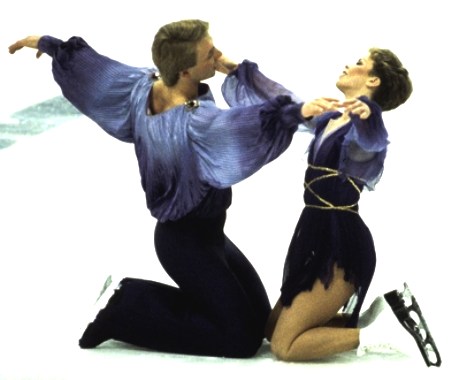
Brazil
Ismael Toledo was one of the first b-boys in Brazil. In 1984, he moved to the United States to study
dance. While in the U.S. he discovered breaking and ended up meeting b-boy Crazy Legs who personally mentored him for the four years that
followed. After becoming proficient in breaking, he moved back to São Paulo and started to organize b-boys crews and enter international
competitions. He eventually opened a hip-hop dance studio called the Hip-Hop Street
College.
South Korea
B-boying was first introduced to South Korea by American soldiers shortly after its surge of popularity in the U.S. during the 1980s, but it was not until the late 1990s that the culture and dance really took
hold. 1997 is known as the "Year Zero of Korean breaking". A Korean-American hip hop promoter named John Jay Chon was visiting his family in
Seoul and while he was there, he met a crew named Expression Crew in a club. He gave them a VHS of a Los Angeles b-boying competition called Radiotron. A year later when he returned, Chon found that his video and others like his had been copied and dubbed numerous times, and were feeding an ever-growing b-boy community.
In 2002, Korea's Expression Crew won the prestigious international b-boying competition Battle of the Year, exposing the skill of the country's b-boys to the rest of the world. Since then, the Korean government has capitalized on the popularity of the dance and has promoted it alongside Korean culture. R-16 Korea is the most well-known government-sponsored b-boy event, and is hosted by the Korean Tourism Organization and supported by the Ministry of Culture, Sports, and Tourism.
Japan
Shortly after the Rock Steady Crew came to Japan, b-boying within Japan began to thrive. Each Sunday b-boys would perform breaking in Tokyo's Yoyogi
Park. One of the first and most influential Japanese breakers was Crazy-A, who is now the leader of the Tokyo chapter of Rock Steady
Crew. He also organizes the yearly B-Boy Park which draws upwards of 10,000 fans a year and attempts to expose a wider audience to the culture.
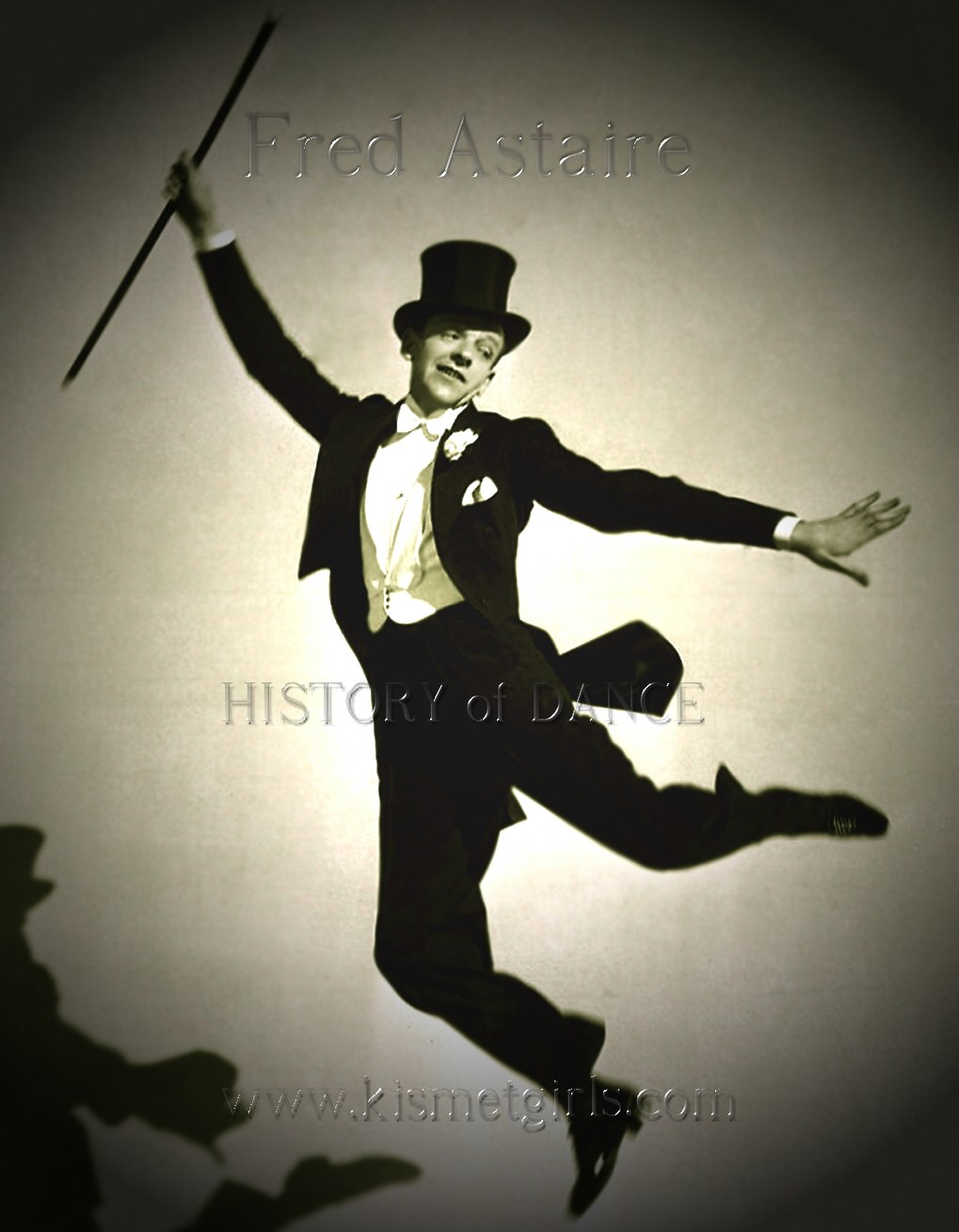
DANCE
ELEMENTS
There are four primary elements that form breaking. These include toprock, downrock, power moves, and freezes/suicides.
Toprock generally refers to any string of steps performed from a standing position. It is usually the first and foremost opening display of style, though dancers often transition from other aspects of breaking to toprock and back. Toprock has a variety of steps which can each be varied according to the dancer's expression (ie. aggressive, calm, excited). A great deal of freedom is allowed in the definition of toprock: as long as the dancer maintains cleanness, form and the b-boy attitude, theoretically anything can be toprock. Toprock can draw upon many other dance styles such as popping, locking, tap dance, or house dance. Transitions from toprock to downrock and power moves are called
"drops".
Downrock (also known as "footwork" or "floorwork") is used to describe any movement on the floor with the hands supporting the dancer as much as the feet. Downrock includes moves such as the foundational 6-step, and its variants such as the 3-step. The most basic of downrock is done entirely on feet and hands but more complex variations can involve the knees when threading limbs through each other.
Power moves are acrobatic moves that require momentum, speed, endurance, strength, and control to execute. The breaker is generally supported by his upper body while the rest of his body creates circular momentum. Some examples are the windmill, swipe, and head spin. Some power moves are borrowed from gymnastics and martial arts. An example of a power move taken from gymnastics is the Thomas Flair which is shortened and spelled flare in b-boying.
Freezes are stylish poses, and the more difficult require the breaker to suspend himself or herself off the ground using upper body strength in poses such as the pike. They are used to emphasize strong beats in the music and often signal the end of a b-boy set. Freezes can be linked into chains or "stacks" where breakers go from freeze to freeze to the music to display musicality and physical strength.
Suicides, like freezes, are used to emphasize a strong beat in the music and signal the end to a routine. In contrast to freezes, suicides draw attention to the motion of falling or losing control, while freezes draw attention to a controlled final position. Breakers will make it appear that they have lost control and fall onto their backs, stomachs, etc. The more painful the suicide appears, the more impressive it is, but breakers execute them in a way to minimize pain.
TELEVISION
In the United States, the dance shows So You Think You Can Dance and America's Best Dance Crew arguably presented b-boying back to the forefront of America's pop culture, similar to the popularity it had in the 80s. B-boying is widely referenced in
TV advertising, as well as news, travelogue, and documentary segments, as an indicator of youth/street culture. From a production point of view the style is visually arresting, instantly recognizable and adducible to fast-editing, while the ethos is multi-ethnic, energetic and edgy, but free from the gangster-laden overtones of much rap-culture imagery. Its usability as a visual cliché benefits sponsorship, despite the relatively small following of the genre itself beyond the circle of its practitioners. In 2005, a
Volkswagen Golf GTi commercial featured a partly CGI version of Gene Kelly popping and b-boying to a remix of "Singin' in the Rain", by Mint Royale. The tagline was, "The original, updated."
Since b-boying's popularity surge in South Korea, it has been featured in various TV dramas and commercials. Break is a 2006 mini series from Korea about a b-boying competition. Over the Rainbow (Drama series 2006) centers on different characters who are brought together by b-boying.
TRADITIONAL
DANCE ORIGINS
Dance (from French
danser, perhaps from Frankish) generally refers to movement of the body, usually rhythmic and to
music, used as a form of expression, social interaction or presented in a spiritual or performance setting.
Dance is also used to describe methods of non-verbal communication (see body language) between
humans or animals (bee dance, patterns of behaviour such as a mating dance), motion in inanimate objects (the leaves danced in the
wind), and certain musical forms or genres.
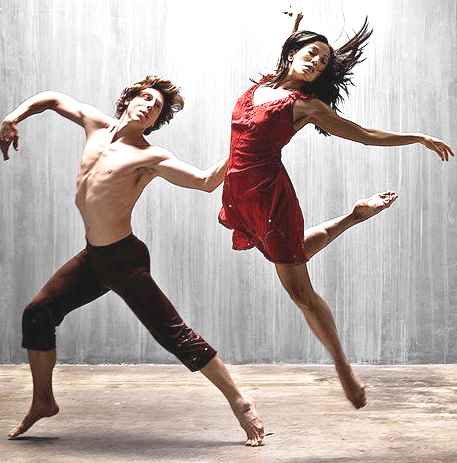
Athletic
stage dancers
Definitions of what constitutes dance are dependent on social, cultural, aesthetic, artistic and moral constraints and range from functional movement (such as folk dance) to virtuoso techniques such as ballet. In
sports, gymnastics, figure skating and synchronized swimming are dance disciplines while martial arts kata are often compared to dances.
Dance can be participatory, social or performed for an audience. It can also be ceremonial, competitive or erotic. Dance movements may be without significance in themselves, such as in ballet or
European folk dance, or have a gestural vocabulary/symbolic system as in many Asian dances. Dance can embody or express ideas, emotions or tell a story.
Choreography is the art of creating dances, and the person who does this is called a choreographer.
Origins and history of dance
Pietro Longhi, "La lezione di danza" (The Dancing Lesson), ca 1741, Venezia, Gallerie dell'Accademia.Dance does not leave behind clearly identifiable physical artifacts such as stone tools, hunting implements or cave painting. It is not possible to say when dance became part of human culture. Dance has certainly been an important part of ceremony, rituals, celebrations and entertainment since before the birth of the earliest human civilizations. Archeology delivers traces of dance from prehistoric times such as Egyptian tomb paintings depicting dancing figures from circa 3300 BC and the Rock Shelters of Bhimbetka paintings in India.
One of the earliest structured uses of dance may have been in the performance and telling of myths. Before the introduction of written languages, dance was one of the methods of passing these stories down from generation to generation.
Another early use of dance may have been as a precursor to ecstatic trance states in healing rituals. Dance is still used for this purpose by cultures from the Brazilian rainforest to the Kalahari
Desert.
Sri Lankan dances goes back to the mythological times of aboriginal yingyang twins and "yakkas" (devils). According to a Sinhalese legend, Kandyan dances originate, 2500 years ago, from a magic ritual that broke the spell on a bewitched king. Many contemporary dance forms can be traced back to historical, traditional, ceremonial, and ethnic dances.
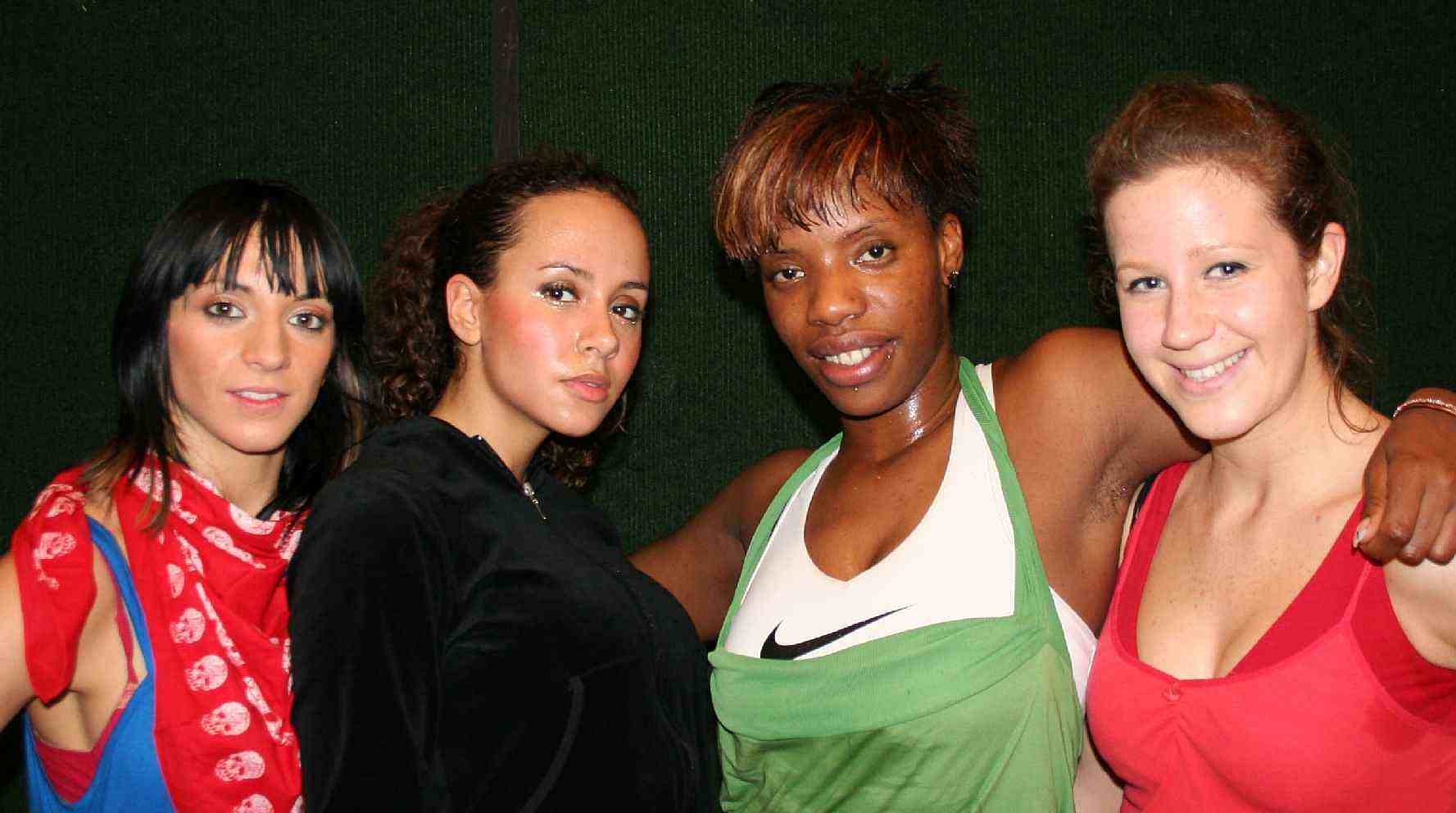
Left
to right: Lizzie, Simone, Tasmin, Lauren
modern dance troupe
Photos ©
NJK 2008
Dance classification and genres
Partner dance
Dance categories by number of interacting dancers are mainly Solo dance, Partner dance and Group dance. Dance is preformed for various purposes like Ceremonial dance, Erotic dance, Performance dance, Social dance etc.
Dancing and music
Many early forms of music and dance were created and performed together. This paired development has continued through the ages with dance/music forms such as: Jig, Waltz, Tango, Disco, Salsa, Electronica and Hip-Hop. Some musical genres also have a parallel dance form such as Baroque music and Baroque dance whereas others developed separately: Classical music, Classical ballet.
Although dance is often accompanied by music, it can also be presented independently or provide its own accompaniment (tap dance). Dance presented with music may or may not be performed in time to the music depending on the style of dance. Dance performed without music is said to be danced to its own rhythm.
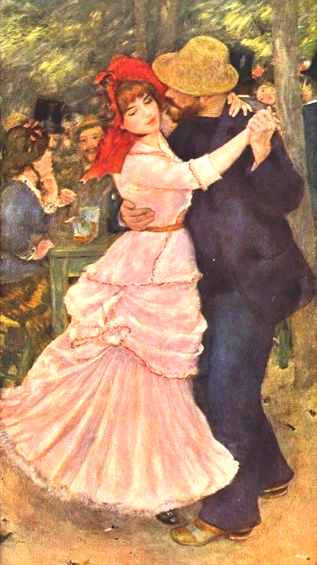
Painting of couple dancing by Pierre Auguste Renoir
Dance studies and techniques
In the early 1920s dance studies (dance practice, critical theory, Musical analysis and history) began to be considered an academic discipline. Today these studies are an integral part of many universities' arts and humanities programs. By the late 20th century the recognition of practical knowledge as equal to academic knowledge lead to the emergence of practice-based research and practice as research. A large range of dance courses are available including:
-
Professional practice: performance and technical skills
-
Practice-based research: choreography and performance
-
Ethnochoreology, encompassing the dance-related aspects of Anthropology, Cultural Studies, Gender Studies, Area studies, Postcolonial theory, Ethnography, etc.
-
Dance therapy or Dance-Movement Therapy.
-
Dance and technology: new media and performance technologies.
-
Laban Movement Analysis and Somatic studies
-
A full range of Academic degrees are available from BA (Hons) to PhD and other postdoctoral fellowships, with many dance scholars taking up their studies as mature students after a professional dance career.
Dancing is evolving in so many different styles. Breakdancing and Crumping which is related to the hip hop culture.
African dance which is interperative. Ballet, Ballroom, Waltz, and Tango are classical styles of dance. While square and the infamous electric slide are forms of step dances.

Kismet
Girls - modern dance proponents
Dance competitions
An amateur dancesport competition at MIT.A dance competition is an organized event in which contestants perform dances before a common group of judges for awards and, in some cases, monetary prizes. There are several major types of dance competitions, distinguished primarily by the style or styles of dances performed. Major types of dance competitions include:
Competitive dance, in which a variety of dance styles—typically including acro, ballet, jazz, hip-hop, lyrical, and tap—are permitted. A popular example of this is the TV program So You Think You Can Dance
Dancesport, which is focused exclusively on ballroom and latin dance. A popular example of this is the TV program Dancing with the Stars.
Single-style competitions, such as highland dance, dance team, and Irish dance, which only permit a single dance style.
Dance occupations
There are different careers connected with dancing: Dancer, dance teacher, dance sport coach, dance therapist and choreographer.
Dancer
Dance training differs depending on the dance form. There are university programs and schools associated with professional dance companies for training in classical dance (e.g. Ballet) and modern dance. There are also smaller, privately owned dance studios where students may train in a variety of dance forms including competitive dance forms (e.g. Latin dance, ballroom dance, etc.) as well as ethnic/traditional dance forms.
Professional dancers are usually employed on contract or for particular performances/productions. The professional life of a dancer is generally one of constantly changing work situations, strong competition pressure and low pay. Professional dancers often need to supplement their income, either in dance related roles (e.g., dance teaching, dance sport coaches, yoga or Pilates instruction) to achieve financial stability.
In the U.S. many professional dancers are members of unions such as the American Guild of Musical Artists, the Screen Actors Guild and Actors' Equity Association. The unions help determine working conditions and minimum salaries for their members.
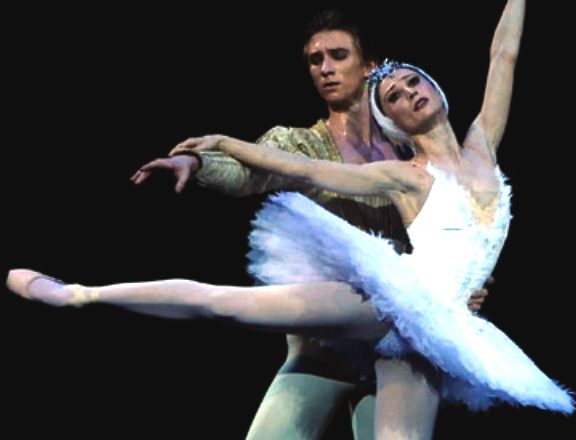
Dance teachers
Dance teacher and operators of dance schools rely on reputation and marketing. For dance forms without an association structure such as Salsa or Tango Argentino they may not have formal training. Most dance teachers are self employed.
Dancesport coaches
Dancesport coaches are tournament dancers or former dancesports people, and may be recognised by a dance sport federation.
Choreographer
Choreographers are generally university trained and are typically employed for particular projects or, more rarely may work on contract as the resident choreographer for a specific dance company. A choreographic work is protected intellectual property. Dancers may undertake their own choreography.
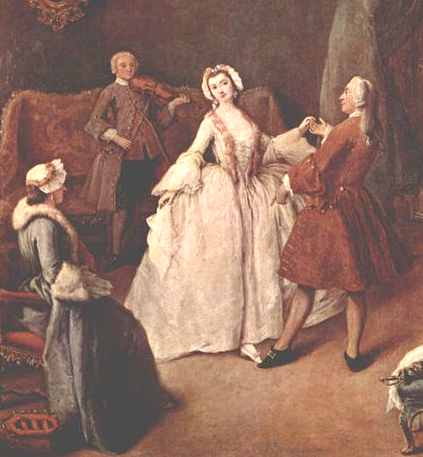
Painting by Pietro Longhi
Dance by ethnicity or region
India
Dance in Indian canonical literature: In the first millennium BCE in India many texts were composed which sought to state the rules of social management, private life, linguistic discipline, public finance, state policy, poetics, and dramatics. In the matter of dance, Bharata Muni's Natyashastra (literally "the art of dance") is the one of the earlier texts.
Though the main theme of Natyashastra deals with drama, dance also finds mention. It elaborates various gestures of hands and classifies such gestures and movements as either graceful or vigorous, defining the lalita form of dance - lasya; and the vigorous form 'tandava'.
Dance is classified under four categories and into four regional varieties. Natyashastra names these categories as secular, ritual, abstract, and, interpretive. Regional geography has altered since ancient India's time and so have regional varieties of Indian dances. Dances like "Odra Magadhi", which after decades long debate, has been traced to present day Mithila-Orissa region's dance form of Odissi, indicate influence of dances in cultural interactions between different regions.[4]
The roots of the present day Kathak, Bharatanatyam, Odissi, Mohini Attam and Kuchipudi are found in ancient Indian civilization. Abstractness is now the feature of almost all classical Indian dance forms.
Classical Indian dance since 1947: During the reign of the last 'Mughals' and Nawabs of Oudh dance fell down to the status of 'nautch', a sensuous dance of courtesans.
Later, linking dance with immoral trafficking and prostitution, British rule prohibited public performance of dance. Many disapproved it. In 1947, India won her freedom and for dance an ambience where it could regain its past glory. Classical forms and regional distinctions were re-discovered, ethnic specialties were honored.
Archaeology delivers traces of dance from prehistoric times such as Egyptian tomb paintings depicting dancing figures from circa 3300 BC and the Bhimbetka rock-shelter paintings in India.
Bhangra in the Punjab
The Punjab area overlapping India and Pakistan is the place of origin of Bhangra. It is widely known both as a style of music and a dance. It is mostly related to ancient harvest celebrations, love, patriotism or current social issues. Its music is coordinated by a musical instrument called the 'Dhol'. Its beats is what gives the human body the vibes in the dance movements. Bhangra isn't just music but a dance. It's actually the celebration of the harvest where people beat the dhol (drum), sing Boliyaan (lyrics) and dance!
Dances of Sri Lanka
The devil dances of Sri Lank] or "yakun natima" are a carefully crafted ritual with a history reaching far back into Sri Lanka's pre-Buddhist past. It combines ancient "Ayurvedic" concepts of disease causation with psychological manipulation. The dance combines many aspects including Sinhalese cosmolgy, the dances also has an impact on the classical dances of Sri
Lanka.
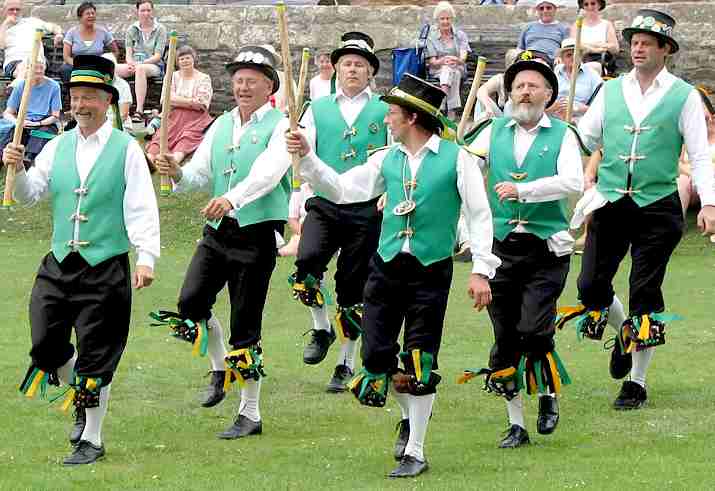
Morris dancing in the grounds of Wells Cathedral, Wells, England
In Europe and North America
Ballet developed first in Italy and then in France from lavish court spectacles that combined music, drama, poetry, song, costumes and dance. Members of the court nobility took part as performers. During the reign of Louis XIV, himself a dancer, dance became more codified. Professional dancers began to take the place of court amateurs, and ballet masters were licensed by the French government. The first ballet dance academy was the Académie Royale de Danse (Royal Dance Academy), opened in Paris in 1661. Shortly thereafter, the first institutionalized ballet troupe, associated with the Academy, was formed; this troupe began as an all-male ensemble but by 1681 opened to include women as
well.
During the 18th century, ballets were still mainly performed alongside opera or poetry, but the idea of dance performance as separate from sung or spoken word began to be experimented with. Mime, instead, was used to tell the stories of these ballets. Female professional dancers began to take their place onstage, having previously been hampered by social norms; they performed in high-heeled shoes and long, full skirts. Later they wore short, stiff, yet fluffy, skirts called tutus.
During the Pre-Romantic era in ballet, the art form changed rapidly. Costume reforms were made, especially for women; these reforms were in part a result of the French Revolution. Heeled street shoes were replaced by slippers, and corsets and heavy petticoats were discarded, and tights were invented. Simple en pointe work was introduced by ballerinas such as Fanny Elssler and Marie Taglioni, who heavily darned their slippers in order to be able to rise up briefly on their toes. The seven movements of dance (to bend, to rise, to stretch, to glide, to jump, to turn, and to dart) were codified in 1796.
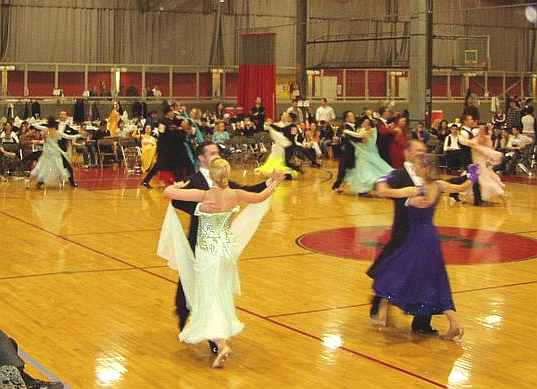
Classic
ballroom dancing competition
The period of time between 1830 and 1870 is classified as the Romantic era of ballet. A format developed for ballets crafted in this period: the first act was set in the real world and the second in a supernatural or otherworldly setting. Most ballerinas portrayed creatures such as wilis, sylphs and nymphs wearing long white skirts, today called Romantic tutus. Ballets choreographed during this time period included Giselle in 1841, La Sylphide in 1832, and Coppelia in 1870. The Romantic Era came to a close when ballet lost popularity in Western Europe due to competition by music halls and a lack of strong male dancers and choreography.
St. Petersburg became the center of ballet during the second half of the 19th century; the art form was supported by the patronage of the czars and the success of the Imperial Ballet, its school (forerunner of the Kirov Ballet) and the talent of Marius Petipa. Hard or blocked pointe shoes were introduced during this period, as were short tutus (today known as classical tutus, these skirts take their name from this era, which was the Russian Classical). Many story ballets (The Nutcracker, Don Quixote, Swan Lake, The Sleeping Beauty, Le Corsaire) were produced during this period. Although the coming of the Russian Revolution boded ill for the art form, Nicholas Sergeyev, last régisseur of the Imperial Ballet, smuggled the choreographic notation documenting the Imperial Ballet's repertory out of Russia and into the West. Hence many of the ballets survived, and are still performed today.
Fred Astaire, one the most influential dancers of the 20th century, dancing on the walls and ceiling in the film Royal Wedding (1951)The Russian impresario Serge Diaghilev was instrumental in bringing ballet back to Western Europe and allowing for its
evolution into a 20th century art form. Although not a dancer nor a choreographer, Diaghilev was an avid dance and music patron. He assembled a troupe of Russian composers, dancers, choreographers and designers; as the Diaghilev Ballet Russes, this troupe toured Europe and the United States. Diaghilev was one of the foremost influences upon ballet in the new century, and he helped to launch the careers of such artists as Anna Pavlova, Michel Fokine, Vaslav Nijinsky, and George Balanchine, among others. After Diaghilev's death, the company disbanded. Many of his dancers settled in Western Europe and the United States. Michel Fokine joined American Ballet Theatre in 1940 as its resident choreographer; George Balanchine also came to America and founded the New York City Ballet in 1934. It was Balanchine who developed what is now known as the "neo-classical" style of ballet.
At the beginning of the 20th century, there was an explosion of innovation in dance style characterized by an exploration of freer technique. Early pioneers of what became known as modern dance include Loie Fuller, Isadora Duncan, Mary Wigman and Ruth St. Denis. The relationship of music to dance serves as the basis for Eurhythmics, devised by Emile Jaques-Dalcroze, which was influential to the development of Modern dance and modern ballet through artists such as Marie Rambert.
Eurythmy, developed by Rudolf Steiner and Lori Maier-Smits, combines formal elements reminiscent of traditional dance with the new freer style, and introduced a complex new vocabulary to dance. In the 1920s, important founders of the new style such as Martha Graham and Doris Humphrey began their work. Since this time, a wide variety of dance styles have been developed; see Modern dance.
The United States
African American dances are those dances which have developed within African American communities in everyday spaces, rather than in dance studios, schools or companies and its derivatives, tap dance, disco, jazz dance, swing dance, hip hop dance and breakdance. Other dances, such as the lindy hop with its relationship to rock and roll music and rock and roll dance have also had a
global influence.
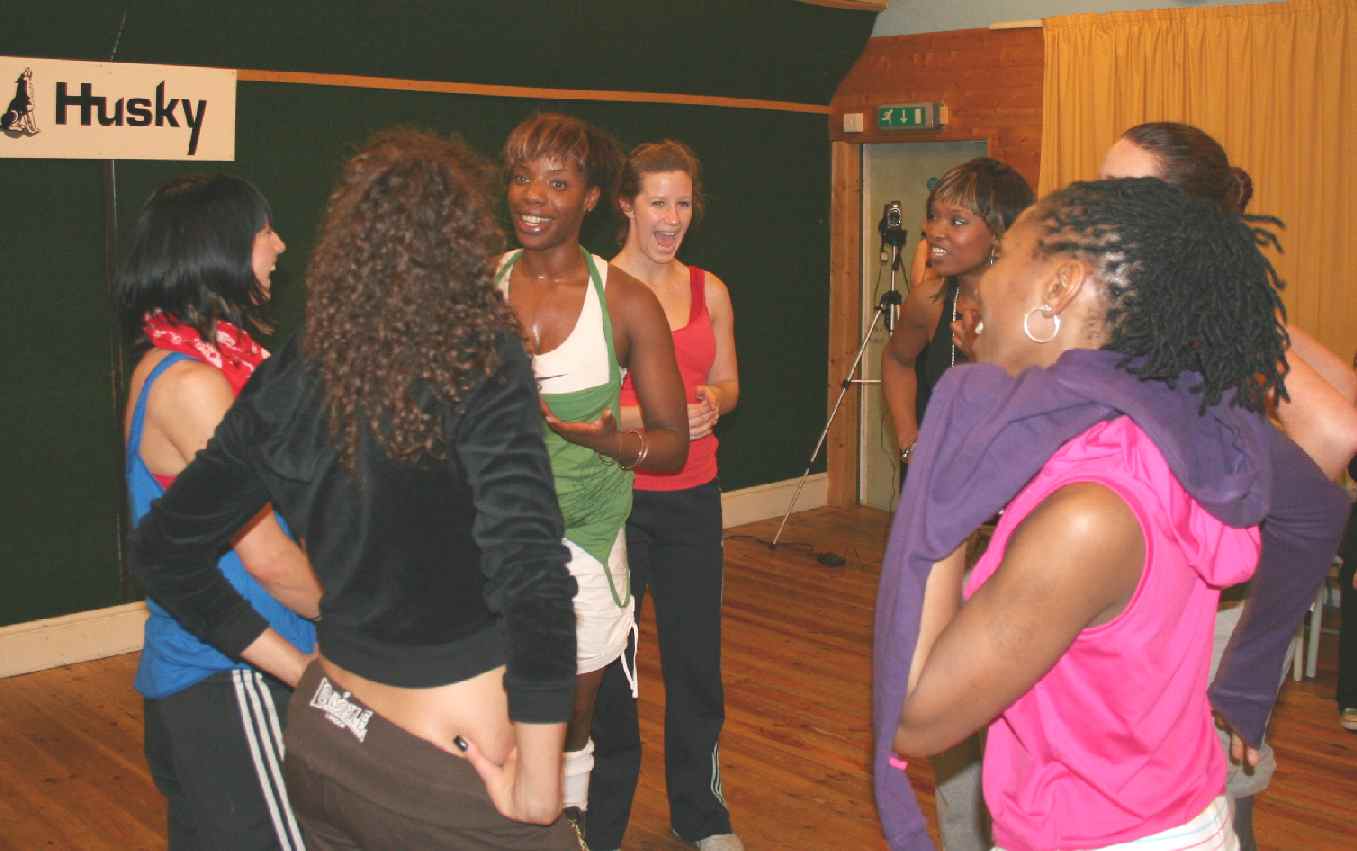
Husky
dance studios Elephant & Castle, London
Photos ©
NJK 2007
LINKS
and REFERENCE
|
Evolution
of Dance
- Youtube
|
Best
Dance
- Youtube
|
|
Ballet
- Youtube
|
Thailand
Talent
- Youtube
|
|
Super
Bass
- Youtube
|
Sistar
- Youtube
|
|
Wavey
Bubble Pop
- Youtube
|
Hip
Hop Battle
- Youtube
|
|
N.Y.
Subway Breakers
- Youtube
|
B
Boy Flip
- Youtube
|
|
Best
Break
- Youtube
|
Extreme
Breakl
- Youtube
|
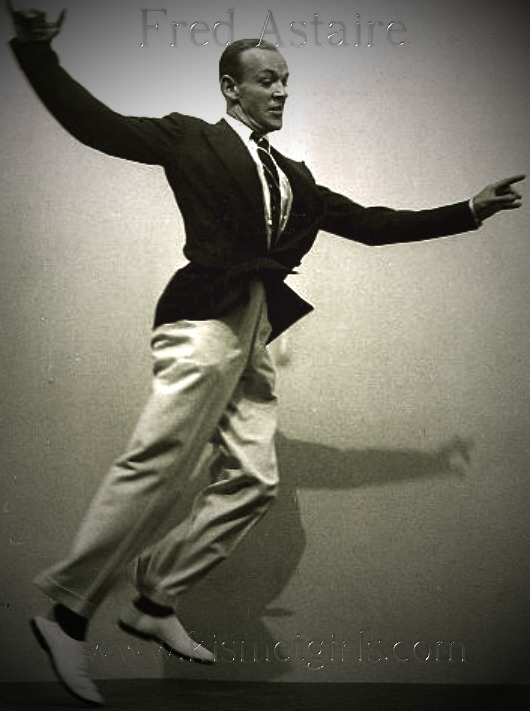
|











